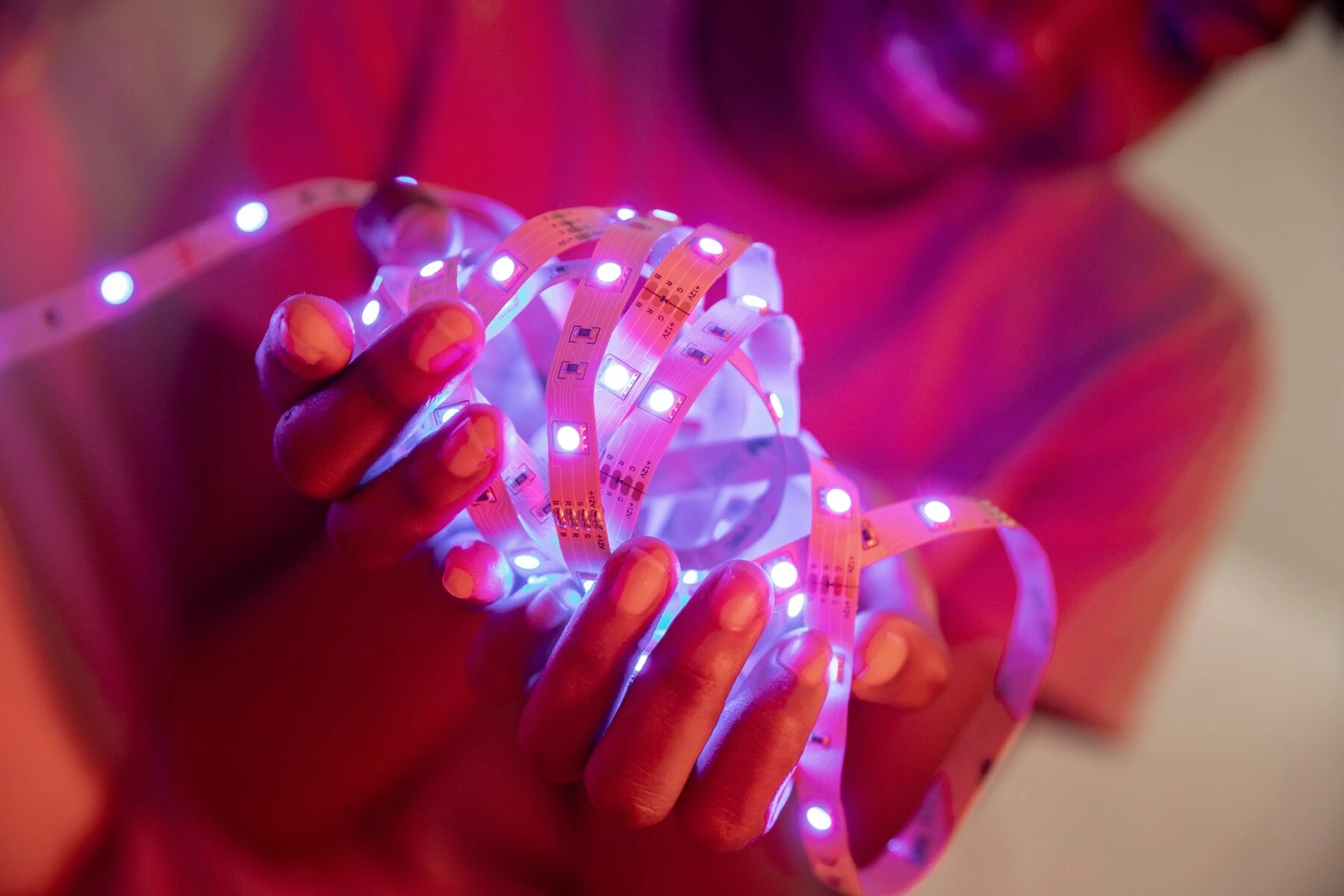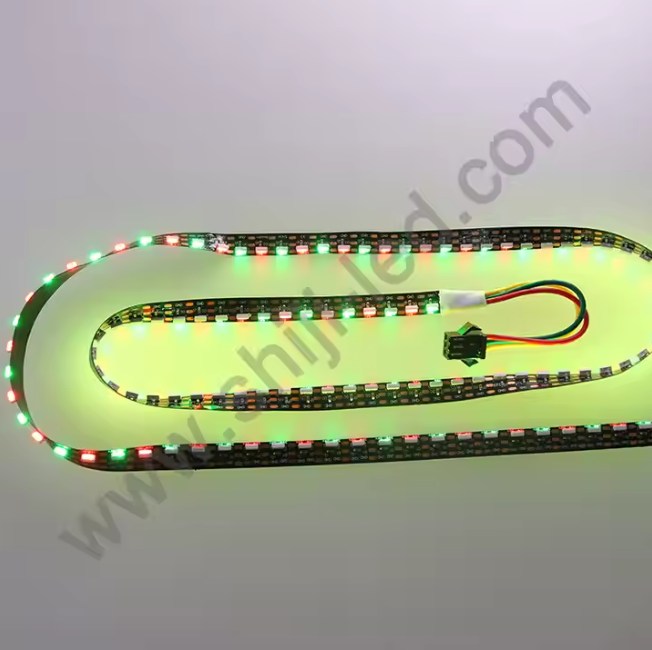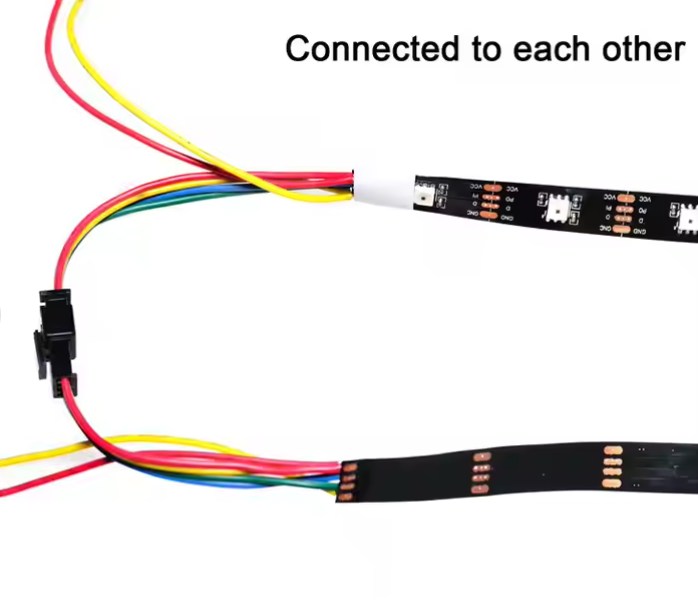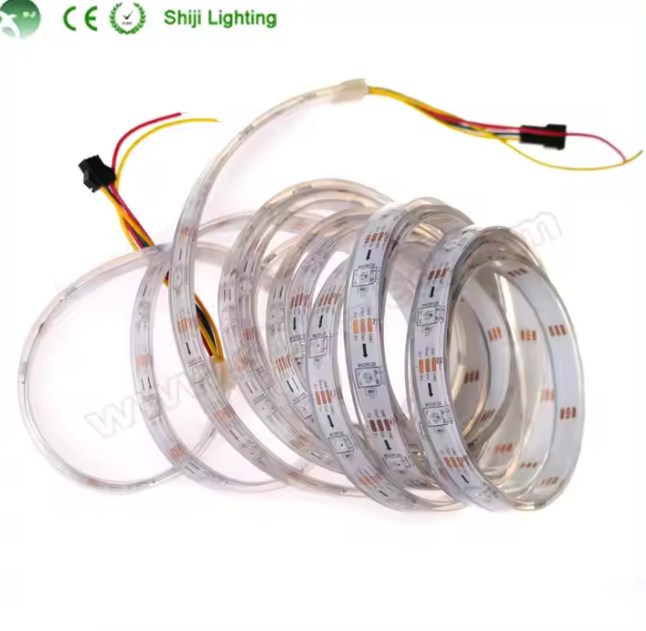Exploring the Versatility of LED Strips
The Appeal of LED Strip Lighting
LED Strip lighting became very popular because of its flexibility, low energy consumption, and bright colors. Flexible PCB material, white PCB and Black PCB optional, dynamic lighting effects can improve the overall look of a place.
Common Applications for LED Strips
LED strips have a wide range of applications both in households and businesses. Ideal for highlighting living spaces, pathway lighting in gardens, and visual pop in retail displays. Indoor/outdoor digital led pixel strings can be used in a wide range of applications.
Advantages of Customizable LED Strip Lighting
There are benefits of using customizable LED strip lights. It is a GS8208, 12V, 5050 LED individual controllable pixel strip, one GS8208 IC control one LED, allowing it to be designed and configured to meet your requirements. The ability to customize these strips adds ambiance and functionality, setting them apart as a top choice for unique lighting solutions.
Technical Aspects of LED Strip Customization
Understanding the Basics of LED Technology
Modern lighting solutions are based on LED technology. These include semiconductor devices that give off light when an electric current is applied to the semiconductor. Lighting source: SMD 5050 RGBW;LED Beam Angle: 120 Degree; IC chip: SK6812. These details tell you about the technical aspects that shape the working of these strips.
Components Required for Customization
Controllers and Power Supplies
To customize LED strips effectively, controllers and power supplies are essential. Controller: SD card controller, Arduino, DMX decoder, and others enable users to manage color changes and brightness levels efficiently.
Connectors and Accessories
Connectors play a crucial role in linking multiple strips together seamlessly. 4Pin JST SM connector on both end and separated Power / Ground Wires ensures reliable connections for consistent performance across installations.
Techniques for Adjusting Color in LED Strips
RGB and RGBW Color Models Explained
Understanding RGB (Red, Green, Blue) and RGBW (Red, Green, Blue, White) models is vital for achieving desired colors in LED strips. These models mix different intensities of colors to produce a wide spectrum of hues.
Methods to Achieve Desired Colors
Using Remote Controls and Apps
Remote controls and mobile apps offer convenient ways to adjust colors in real time. They provide users with intuitive interfaces to select from millions of color options effortlessly.
Manual Adjustment Techniques
For those who prefer hands-on control, manual adjustment techniques involve using physical controllers or switches to fine-tune colors directly on the strip.
Strategies for Modifying Brightness in LED Strips
Factors Influencing Brightness Levels
Several factors influence brightness levels in LED strips, including voltage input and the type of LEDs used. Voltage :DC5V PCB color :White / Black Waterproof Grade: IP20 / IP65 / IP67 / IP68 illustrates how technical specifications impact light output.
Tools for Brightness Control
Dimmers and Smart Controllers
Dimmers allow users to adjust brightness smoothly across a range of levels. Smart controllers offer advanced features like scheduling and automation for enhanced control over lighting conditions.
Software Solutions for Precision Control
Software solutions provide precision control over brightness settings through digital interfaces. These tools enable users to create customized lighting scenarios tailored to specific occasions or moods.
Integrating LED Strips into Various Environments
Indoor vs Outdoor Use Considerations
If you plan to use LED strips in different environments, then there are a few things to take care of, such as the difference between indoor vs outdoor LED strips. This is a built-in IP67 waterproof for the whole string light, it can work outdoors, string light exposure to moisture and weather elements, and it can keep normal use. A flexible design and installation are often preferred for indoor applications. Can be cut to the length required for your application, ideal for tight spaces or other unique shapes.
Creative Installation Ideas for Different Spaces
There are limitless opportunities for creative installations of LED strips across various environments. In homes, they can be utilized to accent architectural elements or mood lighting under cabinets and along stairs. Digital-led pixel string for indoor applications can revolutionize the way retail displays and hospitality venue lighting appear and interact with customers in commercial settings. There are also artistic applications for LED strips, as they can be programmed to change colors and patterns, offering a more interactive experience for art.
Troubleshooting Common Issues in LED Strip Customization
Identifying and Resolving Color Inconsistencies
Voltage drops or bad connections can lead to color differences when your LED strip is customized. Proper power distribution is essential; use separate power/ground wires like Shiji Lighting products which both have 4Pin JST SM connectors on both ends representing color consistency across the entire strip. Besides, checking connectors and compatibility of all elements with specific features of strip placements will ensure that color mismatch is avoided.
Addressing Flickering and Brightness Fluctuations
One of the common problems, when LED strips work is flickering and fluctuation of the brightness. And common reasons/causes for these problems are due to an insufficient power supply or malfunctioning controllers. Moreover, these problems can be resolved by adopting a solid controller solution, such as an SD controller, DMX controller, which promises the stable delivery of the signal as well as the uniformity of the brightness. In addition, the voltage which is inputted into the strip (5V in low voltage) has to keep the range of specification, otherwise, it can ruin the strip and make it work under low performance.
Shiji Lighting: Innovators in LED Solutions
Overview of Shiji Lighting’s Product Range
As an innovator, Shiji Lighting offers a wide range of LED solutions that meet different requirements. APA102C SK9822 DC 5V is a set of addressable smart strip lights that can be bent into any shape and assembled into your desired appearance. Specifically, these products were built to deliver unprecedented color and brightness adjustment control.
Introduction to Other Products like LED Pixel Light
Shiji Lighting also provides other unique products such as LED pixel light in addition to their wide range of LED strips. The lights use technology to independently control each pixel, allowing for complex lighting designs without any vertical space constraints. You can use Shiji Lighting products for indoor/outdoor with different ratings such as IP20 / IP65 / IP67 / IP68.
So these features can be applied while using LED strips in different spaces and the common issues can be solved by customizing it perfectly and using Shiji Lighting to ensure innovation in features that will ensure more creativity and more functional properties for professionals who want to uphold both lights and the environment in which that light is being used. Considering these areas of installation when incorporating LED strips and solving common challenges in customization can enable professionals to maximize their lighting, with the benefits of Shiji Lighting’s innovative product offerings further partnering with the industry for greater creativity and functionality.
FAQ
Q: Why do my LED strips show inconsistent colors across the length?
A: This usually occurs due to voltage drop, especially in long strips. Use a higher-quality power supply, shorten the strip length, or install additional power injection points at intervals.
Q: How can I adjust brightness without affecting color accuracy?
A: Use PWM (Pulse Width Modulation) via a compatible controller to dim the LEDs. Avoid reducing voltage manually, as it may alter color temperature or cause flickering.
Q: Can I connect multiple LED strip controllers to one set of strips?
A: No, overlapping control signals can cause conflicts. Use a single controller with multiple output channels or a centralized system (e.g., DMX) for synchronized control.
Q: What causes LED strips to overheat, and how to prevent it?
A: Overheating is the result of too high current, low airflow, and low-grade materials used. Keep strips cool by putting them in aluminum channels, do not operate strips at maximum power continuously, and have your strips rated correctly. More ways to cool your LED strips are by installing aluminum channels, we also recommend not running your strips over 80% brightness for extended periods, using proper power ratings, and custom-fit heat sinks!
Q: How do I fix LED strips that won’t respond to the controller?
A: Check wiring connections for loose contacts. Reset the controller, ensure compatibility between the controller and strip protocol (e.g., RGB vs. RGBW), and verify power supply stability.






